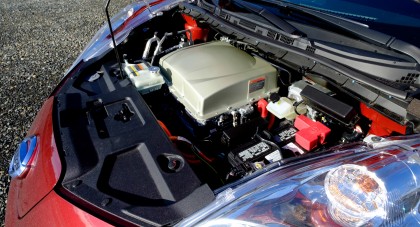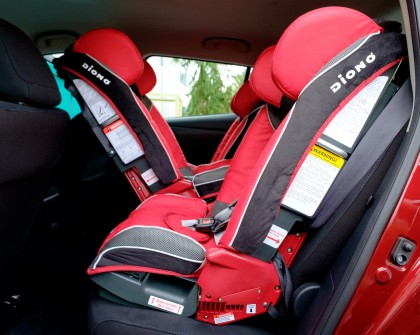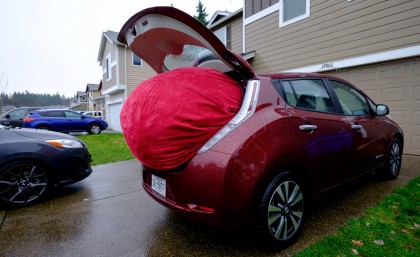Why you can trust TechRadar
The Leaf's powertrain is purely electric. The only fluid to change in the car is brake fluid, but even that can go for at least 60,000 miles. There's also wiper fluid to top off, if you need to wash your windshield and rear windows. This helps cut down on maintenance costs – there are no $60 engine oil changes, transmission fluid changes, timing belts or chains, water pumps or much maintenance at all.
There are standard disc brakes, but the car relies on regenerative braking, which uses the motor to slow the car down while charging the battery pack in the process and reduces wear on the brake pads. These are some of the reasons why my wife wanted a Leaf. (I'm great at maintaining my own car but I slack when it comes to my wife's unexciting cars.)

The motor may sound weak, with a measly 107 horsepower (hp), but don't let the numbers deceive you, as its only part of the equation to power. Torque is what makes the Leaf feel peppy around town, and the car makes 187 pound-feet (lb-ft). Unlike an internal combustion engine that gradually makes more torque, and in result horsepower, as the engine increases the revolutions per minute (RPM), all 187 lb-ft and 107 hp is available instantly at the press of the accelerator pedal.
When you need to accelerate or pass someone on the freeway, all that power is available right away without the transmission downshifting for the optimal power band. It's always available, which is why electric motors are awesome. It doesn't pack the light-speed capabilities of a Tesla Model S, but it's definitely a better experience than an underpowered, economical hatchback.
But, if you have a lead foot like myself, it drains the battery pack faster. New to the 2016 Leaf is the larger 30 kWh battery pack, up from the 24 kWh from earlier models (base S trim still has the 24 kWh unit), that's rated for 107 miles of range, according to the US Environmental Protection Agency (EPA). The 24 kWh battery was rated for 84 miles.
The range rating is for the EPA's testing cycle and varies greatly depending on temperature, climate control use, speed and altitudes traveled, since energy consumption increases greatly if you're constantly going up hills or steep inclines, but regenerative braking charges the pack if you're going back down the same incline.
To test out range, I grabbed my 4-year-old daughter and drove from Graham, Wash. to Kenmore to visit a local camera shop, got lunch and stopped at the Bellevue Nissan dealership to charge. It was an average day in Washington State, which included rain and 40-degree Fahrenheit temperatures. I went easy on the accelerator pedal and drove on the freeway at a steady 60 mph and managed to drive 75 miles with 22% battery left when I reached the CHAdeMO quick-charger.
If you buy a Leaf in the US, Nissan gives you an EZ-Charge card that provides free public charging at select locations. An EZ-Charge card was not included with the Leaf Nissan sent to techradar, but I grabbed my wife's card to use. The dealership chargers were part of the NRG EVgo network, which the EZ-Charge card provides free charging for the first 30-minutes, which is plenty.

I plugged the car in, went into the dealership's warm waiting room and waited 30-minutes for the car to charge. The dealership had a TV to watch, comfortable couches to lounge in with free coffee, apples and vending machines if you wanted snacks or a soda. I sat there playing on my phone while sipping espresso until it was done.
In the 30 minutes of charging, the car gained 70% of capacity, which was plenty to get me home. I went on my way, stopped for some bubble tea and made it home with around 40% of charge left. My entire round trip was about 120 miles, which is a bit further than I usually drive, but I only had to wait 30-minutes to use a quick charger. The Leaf's 30 kWh battery has plenty of range for your typical commute or trips around town.
I'm actually quite jealous of the new battery and wish I waited a year, as the additional capacity easily solves some range anxiety. While our 2015 Leaf with the 24 kWh battery is fine for our trips to Seattle, albeit we have to charge to make it home, trips to Oregon are out of the question. The additional range would at least get us to Oregon, which is 120 miles away, with a single stop at a quick charger, instead of stopping every 40 miles (the CHAdeMo chargers are every 40-miles or so) so we don't get stranded.
In terms of handling, the Leaf feels very nose heavy when diving into turns aggressively, but it's not something a typical Leaf owner should worry about. When driving around the city, the suspension dampens bumps in the roads with comfort. Steering responds to input with precision suitable for a daily driver, but don't expect sports car road feel and precision. Overall, it does the job it was built for, and if you're not a performance-oriented driver, like myself, you'll be satisfied.
Living with the car
Living with an EV is a different experience, as you can't stop at a gas station to fill up. The car has to charge at home or in public. I personally charge my Leaf at home with a Bosch 30-amp Level 2 (240V) charger, while some people are perfectly happy with the included Level 1 (120V) charger.
Charging times are significantly longer with Level 1, which can take over a day to charge a completely depleted battery, whereas a Level 2 takes around 6 hours. If you constantly deplete the battery for your drive, I highly suggest a Level 2 charger, but if you're only running around town, the included Level 1 may be enough.
As for family-friendliness of the car, we partnered up with Diono, a car seat manufacturer, to test-fit three car seats in the back of the Leaf. Diono's USA headquarters is in Puyallup, Wash., where I conduct vehicle testing and a convenient place to stop by and test-fit car seats. With the help of Diono, I attempted to install three Radian RXT convertible car seats in the back of the Leaf.

The Leaf features two lower LATCH anchors for the outboard seats, which is typical for most cars. Three top LATCH anchors are available on the back of the seats. I chose to install the car seats with the 3-point seat belt as the lower LATCH anchors have weight limits of up to 65 pounds. The Leaf passed the test and was able to fit two forward and one rear-facing, or three forward-facing car seats without any trouble.
Nissan made the seats plush, which made it very easy to install the seat and get it very tight, using the seat belt. Despite the small size, the Leaf is the smallest car that can fit three car seats in forward and rear-facing configurations.
Junk in the trunk
The Leaf's hatchback design gives it 23.6 cubic feet (cu-ft) of trunk space, which is a little more than the Honda HR-V we tested. Nissan equips the car with passive keyless entry, so the hatch can be opened if the key fob is in your pocket. I'll give Nissan credit for the buttons available on the hatch, two buttons are available: one rectangular button that releases the trunk hatch and one smaller circular that locks or unlocks the car. The subtle nicety is helpful if you get out of the car, take something out of the trunk and lock the car without having to walk around to the front door or taking the keyfob out of your pocket.
I keep a Sumo Gigantor and Omni from Sumo Lounge around for trunk space testing. The Gigantor is a little too big to carry in and out of my house, so I stick to using the Omni for most cars. It's a fun way I devised to show how big a trunk is.

I dragged the Sumo Omni outside on a rainy day, which is typical for most of the year in Washington State, and shoved the bean bag into the back of the Leaf. I got the bean bag a third of the way in with the back seats up, and it should fit fine with the seats down. The sloped rear hatch of the Leaf, intended for aerodynamics, may prevent large and tall objects from fitting in the cargo area, if you must have rear passengers.
The load height is quite high and not completely flat to the trunk opening, so it's not ideal for loading or unloading heavier objects. Overall, the trunk space is adequate for a kid's stroller, but the car isn't ideal for transporting heavy and large-sized items.
Current page: Performance and living with it
Prev Page NissanConnect EV, Audio and Around View Monitor Next Page Verdict